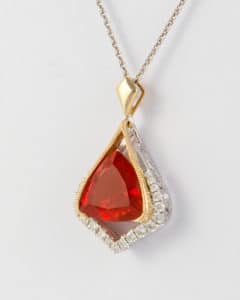
Opal is a gem unlike any other. William Shakespeare once wrote that the opal was the “queen of gems.” Once you see a fine opal, you’ll understand why. Because you experience opal. They are dynamic, lively, and vibrant. Opal’s flashes of color are so vibrant they’re called fire.
Some people believe it’s unlucky to wear opals if you weren’t born in October. But that actually comes from a Sir Walter Scott novel of the 1800s, not from any ancient beliefs. On the contrary, most cultures believe opal to be lucky and magical.
Opal Meanings
- Opal helps you feel your creativity. Therefore, it provides inspiration and imagination to all situations.
- Use opal to strengthen your memory.
- Opal instills faithfulness and loyalty to relationships of love, personal affiliations, and business relationships.
- Wear opal to be “invisible” in situations when you don’t want to be noticed.
- Opals have been used to disperse infections, to purify the blood and stimulate circulatory functions.
Dynamic Color and Patterns
Its base is usually white or black overall. However, throughout the base, you see vivid streaks and flashes of many colors. Colors come in pinks, greens, blues, oranges, golds. What’s more, they mingle and float across the surface of the stone. You might compare opals to a kaleidoscope. Plus, due to chemical impurities within the stone, the pattern of each opal is as unique as a human fingerprint. Bottom line, opals don’t just come in different colors. Mother Nature has painted a different picture on every opal.
Mexican Fire Opals
Fire opals are translucent or transparent opals with flashes of red, yellow, and orange. Mother Nature creates fire opals in a base rock. Much like you see in Australian opals except in orange colors. Or, sometimes you find a completely crystal gem. We love both types. Iron oxide impurities cause these colors. These beauties are mostly found in Mexico, although some are mined in Nevada.

Opal Formation
Most importantly, opals are composed of submicroscopic fragments of silica. In addition, these fragments are held together with more silica and water. Varying amounts of water within the mineral gives each stone its unique appearance. Opals are formed inside near-surface volcanic rocks. Their formation occurs as very hot water in the ground dissolves the silica into a gel. The gel eventually re-forms as a gemstone. Similarly, some fossils, such as shells, bones, or wood, can become opalized.
Opal is a delicate stone. If the water inside it evaporates, it can shrink or crack. It is a relatively soft porous material. And, its appearance can change when it is exposed to changes in extreme heat or pressure.
Because opals are so soft, they are usually turned into cabochons for use in jewelry. Rather than cutting facets into the stone, cabochons are smoothed and polished. These are styled in various degrees of a dome shape. Opals are best set in brooches, earrings, necklaces, and pendants. Or as a carefully worn ring. But, not for everyday wear.
History & Lore
During Medieval times, changes in an opal’s color intensity were thought to reflect the health of its wearer. The stones were believed to prevent fainting and infection, keep hearts healthy, and cleanse dirty air.
Native Americans and Australian aboriginal shamen used opals to invoke visions. Legends and superstitions about opals exist in ancient and modern cultures all over the world. Therefore, stories come from many different places like Rome, India, Australia, the Middle East, and eastern Asia.
Where Opals Come From
Today, the majority of opals are mined in Australia, especially famous for its black opals. Other sources include Ireland, Japan, Ethiopia, Brazil, Honduras, Guatemala, and Nicaragua. Next, you find Fire opals in Mexico. Plus, NASA has even discovered opal deposits on Mars!
We love opals! You’ll always find a good selection of October’s birthstone, opal. At Copeland’s, we carry loose opals and opal jewelry.
